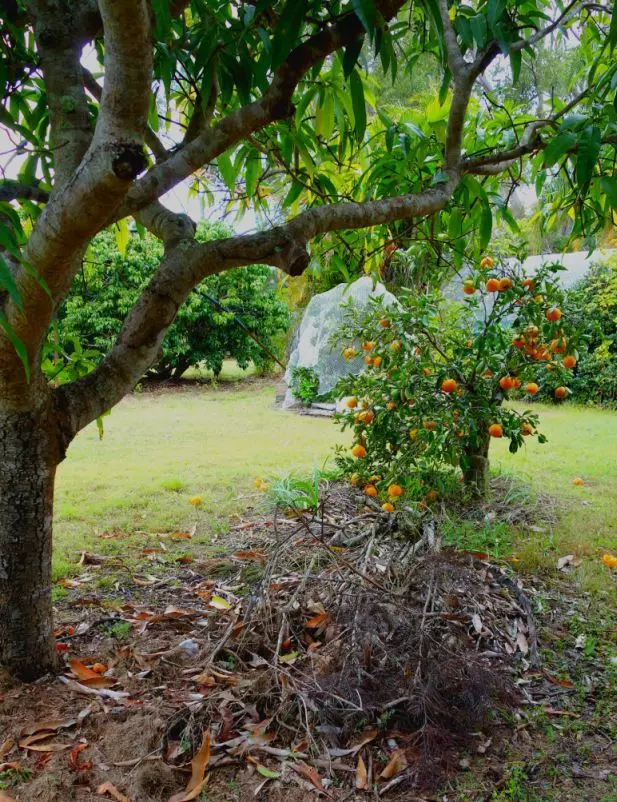
I’ll happily admit to practising the art of lazy gardening!
Years ago, we used to make our gardens pristine, with rows of plants all the same height, lawns mowed within an inch of their life, annual flowers planted with perfect spacing, and trees all neatly pruned…in other words, a green desert. While our gardens were manicured, watered and well cared for, there was nowhere for insects, microflora and microfauna to exist, and I began to wonder how I could expect my flowers and veggies to be pollinated or protected by predatory insects if there was no food or habitat for them.
These days, I love my garden just as much, but I don’t want to be tied to it 24/7. I now favour a more natural look, where I’m not forcing my plants to conform to some sort of ideal of how it ‘should look’. My lazy garden has prolific border beds with lots of flowers which attract essential pollinator insects & I have thriving veggies as a result. Sometimes it looks untidy, other times its unkempt…and I’m okay with that! If you aspire to a show garden, good luck to you- but be aware that wildlife may not find a home there, and you might just find yourself applying lots of sprays to maintain the look because the ecosystem is unbalanced. Using my 5 proven time hacks you can increase your gardens abundance while saving time and effort.
Here are my 5 favourite lazy gardening time hacks to help you on your way- they’re super-easy and you can do them too!
CHOP AND DROP. Yes, it’s just as easy as it sounds, AND it helps your garden! When a plant dies or comes to the end of its productive life, I pull it out and either compost it or chop it off and use it as direct mulch.
In the top photo, see a dead shrub I placed under the mango tree. It provides the soil with biome material, vital in this case, as the mango was ailing and not responding to fertiliser. The dead shrub has now been there for 18 months and already the soil under it has changed significantly. I even noticed a big improvement in the fruit last season. As a further benefit, the shrub gives habitat for all sorts of critters, as it’s a prime way to invite all those beneficial birds and insects into our gardens. If you let nature have its way and invite the insects in, they will do much of the work for you. I now have a bearded dragon living under it in summer, insects crawl throughout the branches, plus the birds take what they need for use as nesting material. For more details on some of the beneficial insects in the garden, see our detailed articles here.

HARNESS THE POWER OF WEEDS. I like weeds! They flower progressively, so there is always pollen, nectar and fresh leaves to attract beneficials and flying insects. They draw up nutrients from deep in the ground while ploughing the soil for you, plus provide shade for newly establishing seedlings. When they begin to produce too many seeds or start overtaking, I pull most of them and lay them on the ground to form a natural mulch. You can also add weeds to your compost or make a ‘weed tea’ from them, basically a liquid fertiliser to benefit your plants.
DO LESS PRUNING. My lawns are hit and miss & always contain some weeds, mostly due to being shaded by massive trees which I rarely prune. However, those massive trees offer excellent shade and coolth in the summer months, which is the majority of the time here. As I’ve aged I’ve lost the capacity to tolerate the heat and humidity like I could in my younger years. I let the trees grow big so I can follow the shade around all day, rarely venturing into the hot sun. If I have to work in a sunny part, I’ll leave the task until late in the day when it is much cooler. As a result of having large trees I have a patchy lawn, some plants get lanky, and, if food-producing, may fruit poorly. But that’s okay by me, as those lanky plants provide other benefits. The insects got a feed or home, then the compost and worms get a feed, and finally the soil gets a feed. Everything gets something from that lanky plant!

BE A ‘DROUGHT GARDENER’. I never water lawns. Once the rain has stopped for the year, the lawns die back and wait until more rain. My stored water is too precious to waste on lawns. Some parts stay a bit green due to being in the shade or getting a bit of runoff from the household greywater system. That’s enough. In the dry season, I allocate my stored water to the food-producing plants.
In this photo above, I have some clumps of flowers that seed or leave roots in the ground each year. I simply add mulch and a bit of fertiliser and the flowers do the rest. This is a great display considering I gave them almost no water. I do give some water to the ‘pretty’ flowers though, as they offer their own version of mind and spirit health. We should not forget our mental health! If a wide variety of colourful flowers is what our mind likes to see then it should get at least something to gratify itself. I have a large flower garden, mostly bulbs and heat-loving flowers along with some drought-tolerant shrubs.
There is always something in flower at every time of the year. However, those plants that flower and grow lush in the wet season (late summer where I live), die down as the winter months come along and are overtaken by the cool season and dry season plants and flowers. Finally, the bulbs start poking their huge boisterous blooms up out of the mess of leaves that has been covering the soil. They announce the arrival of the summer months with their voluptuous petals and vibrant colours. And the best thing is, all that wonderful colour arrived with very little help from me, because I’m a lazy gardener!

LET PLANTS VOLUNTEER. I love my volunteer plants, they are a great help for the garden. Volunteers are plants that come up all by themselves as a result of plants going to seed before being pulled out. Because I save seed from my own plants to use in the future, I let most of my plants become fully mature- I don’t rip them out as soon as they’ve finished producing. In this way, they drop a lot of seed before I harvest those I want to keep. Additionally, I let many plants self-seed continuously- lettuce, marigolds, rocket, mustards, parsley, flowers, even native fruits, are constantly on the go, so it’s easier to have an ongoing supply of what you like.
In the photo above, I let an old lettuce and a marigold from the previous crop drop their seeds. I shook the plants to release seeds then scuffled the surface. This was the sum total of effort applied to get these baby seedlings! I will apply fertiliser as they grow a bit, but they won’t need more attention than that.
Coming up in part two: how I ‘stack’ these plants so they can all thrive.











